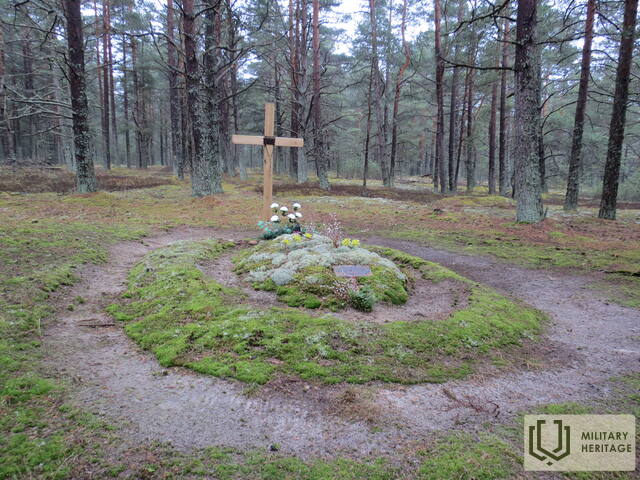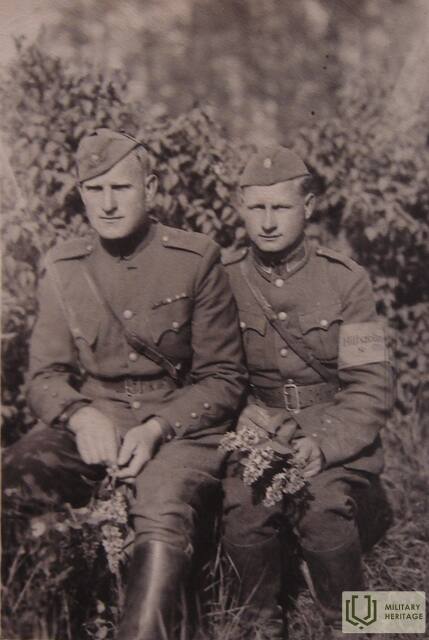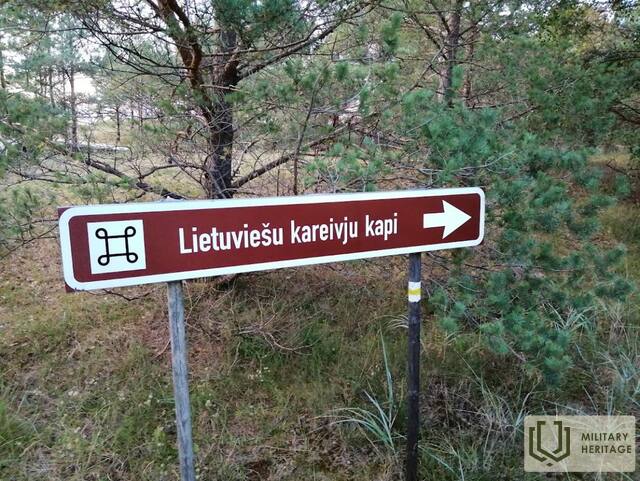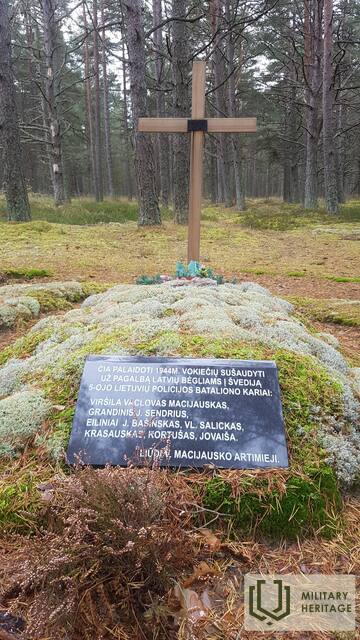Lietuvių karių kapai Zalkalno miške
Memorialinė vieta


 215
215






Memorialas yra netoli Paviluostos paplūdimio apžvalgos bokšto kopose. Yra nuorodos į memorialą.
Antrojo pasaulinio karo pabaigoje Latvijoje taip pat buvo dislokuoti trys Lietuvos policijos batalionai – 5-asis, 13-asis ir 256-asis – kurie, atlikę sargybos pareigas ir kovų su sovietų partizanais bei Raudonąja armija Rytų fronte, nuo 1944 m. rudens dalyvavo Baltijos jūros pakrantės saugojime Kuržemėje.
1944 m. spalį visi trys batalionai, kuriuos sudarė 32 karininkai ir apie 900 instruktorių bei kareivių, buvo pavaldūs Vokietijos 18-osios armijos 583-iajam užnugario apsaugos būriui (Koruck 583). Šiam būriui buvo pavesta saugoti Kuržemės pakrantę nuo Liepojos iki Ventspilio. Visi trys Lietuvos batalionai buvo dislokuoti Paviluostos apylinkėse. 1944 m. gruodį 13-asis batalionas buvo perkeltas į Vokietijos 1-ąjį armijos korpusą prie Liepojos ežero.
Viena iš Lietuvos pakrančių apsaugos užduočių, be pasirengimo kovoti su priešo išsilaipinimais ir pranešti apie priešo laivus, buvo neleisti Latvijos pabėgėlių laivams plaukti į už 160 kilometrų esančią Gotlando salą, tačiau Lietuvos pakrančių apsaugos vyrai nesutrukdė pabėgėlių laivams išplaukti. Tačiau žinia apie Lietuvos pakrančių apsaugos pagalbą Latvijos pabėgėliams ir pačius lietuvius, besiruošiančius kirsti jūrą į Švediją, pasiekė ir vokiečius.
1945 m. sausio 10 d. buvo suimti 5-ojo Lietuvos policijos bataliono 1-osios kuopos kareiviai. Po to vyko daugiau nei savaitę trukę tardymai ir teismas, po kurio, kaip įspėjimas kitiems, buvo nuspręsta sušaudyti septynis Lietuvos kareivius ir vienuolika jų bendražygių įkalinti koncentracijos stovyklose Vokietijoje. Septynių Lietuvos kareivių (kuopos vado seržanto Macijauskio; kareivio Juozo Sendrjua; kareivio Vlado Salicko; Iono Bašinskio Krasausko ir dar dviejų nežinomų asmenų) egzekucija įvyko 1945 m. sausio 21 d. Paviluostos Zaļkalno pušyse.
1945 m. sausį 5-asis batalionas buvo išformuotas, o kovai pasirengę kareiviai padalinti į du likusius batalionus, o likusieji suformuoti į atskirą sapierių kuopą. Armijų grupės „Kurzeme“ kapituliacijos metu 1945 m. gegužę Kuržemėje vis dar buvo du batalionai (13-asis ir 256-asis) kaip sapierių kuopa, kuriuose iš viso buvo 900 kareivių, kurie buvo paimti į sovietų nelaisvę.
Panaudoti šaltiniai ir literatūra:
https://www.la.lv/lietuviesu-karaviru-drama-latvija
https://www.lsm.lv/raksts/dzive--stils/cilvekstasti/latvijas-klusie-varoni-lietuviesi-kas-nelika-skerslus-begliem-doties-pari-jurai-uz-gotlandi.a336877/
Susijusi laiko juosta
Susijusios temos
Susijusi istorija
Pirmasis pabėgėlių laivas „Centība“ iš Bambalio
1944 m. spalio 31 d. laivas „Centība“ išplaukė iš Kuržemės pakrantės. Šio laivo išvykimą, remdamasi kelių bendrakeleivių prisiminimais, atkūrė Latvijos Centrinės Tarybos sušaukėja Valentine Lasmane.
Užjaučiantys Lietuvos pakrančių apsaugos vyrai
Prieš daugiau nei 70 metų Lietuvos pakrančių apsaugos pareigūnai buvo sušaudyti už tai, kad padėjo savo kaimynams, valtimis iš Latvijos išplaukusiems pabėgėliams, pasiekti Švediją. Kai vokiečių okupacinė valdžia apie tai sužinojo, ji žiauriai...
Vokietijos armijos radaro postas Jūrkalnėje
Siekdamos apsaugoti Kuržemės pakrantę nuo galimo sovietų ar net Vakarų sąjungininkų išpuolio, Vokietijos ginkluotosios pajėgos keliose vietose dislokavo radarus, kurie leido daug anksčiau nustatyti priešo oro veiklą. Viena iš jų buvo įrengta Jūrkalnėje.
Pabėgėlių perkėlimo valtimis punktas iš Kuržemės pakrantės į Švediją prie „Pāžių“ namų
Viena iš svarbių perkėlimo vietų buvo netoli „Pāžių“ namų, kur dabar pastatytas paminklas – „Vilties burė“. „Laivai reguliariai atplaukdavo ir daugiausia žmonių išvykdavo iš „Pāžių“, – sako I. Freibergo prisiminimai.







